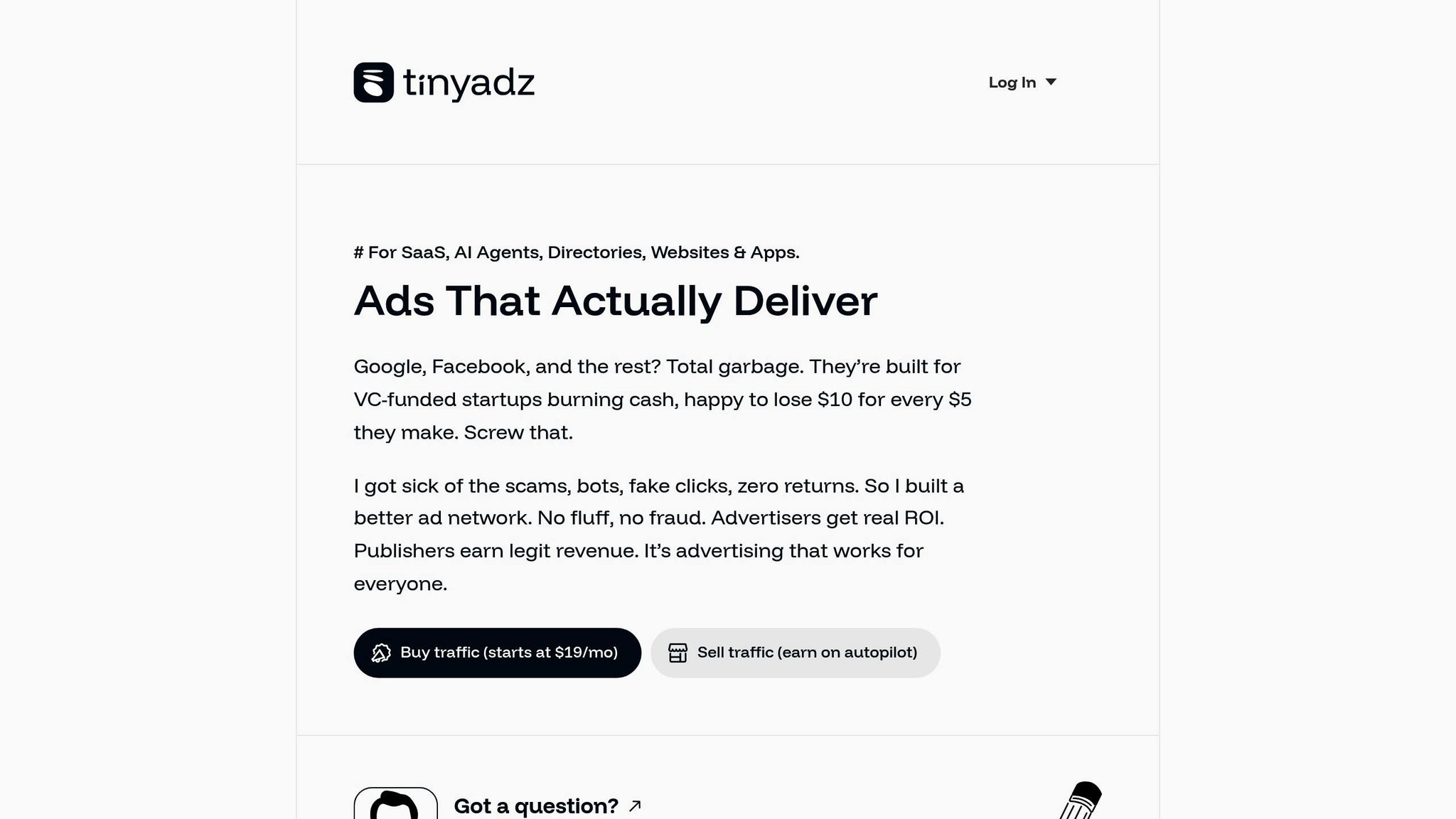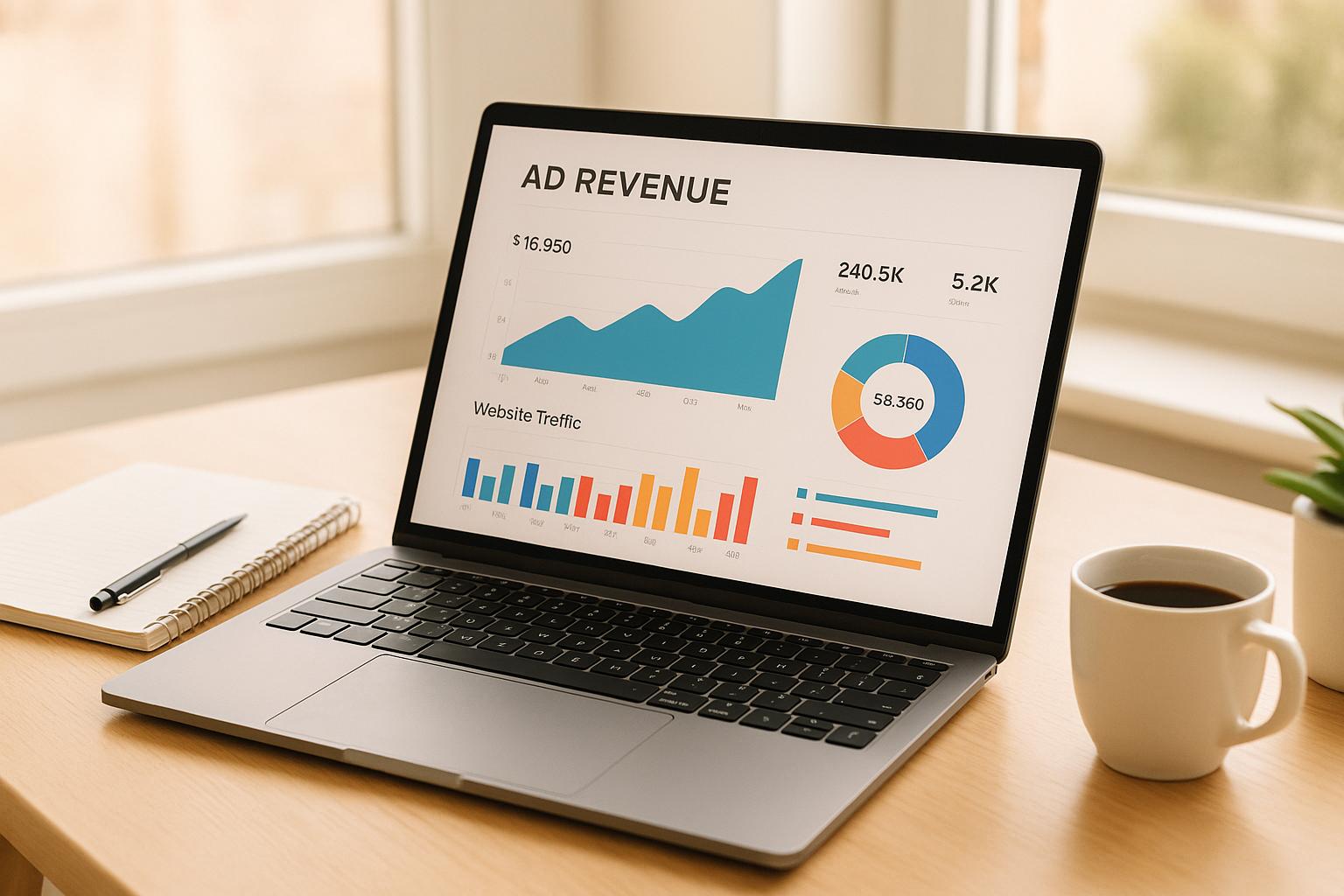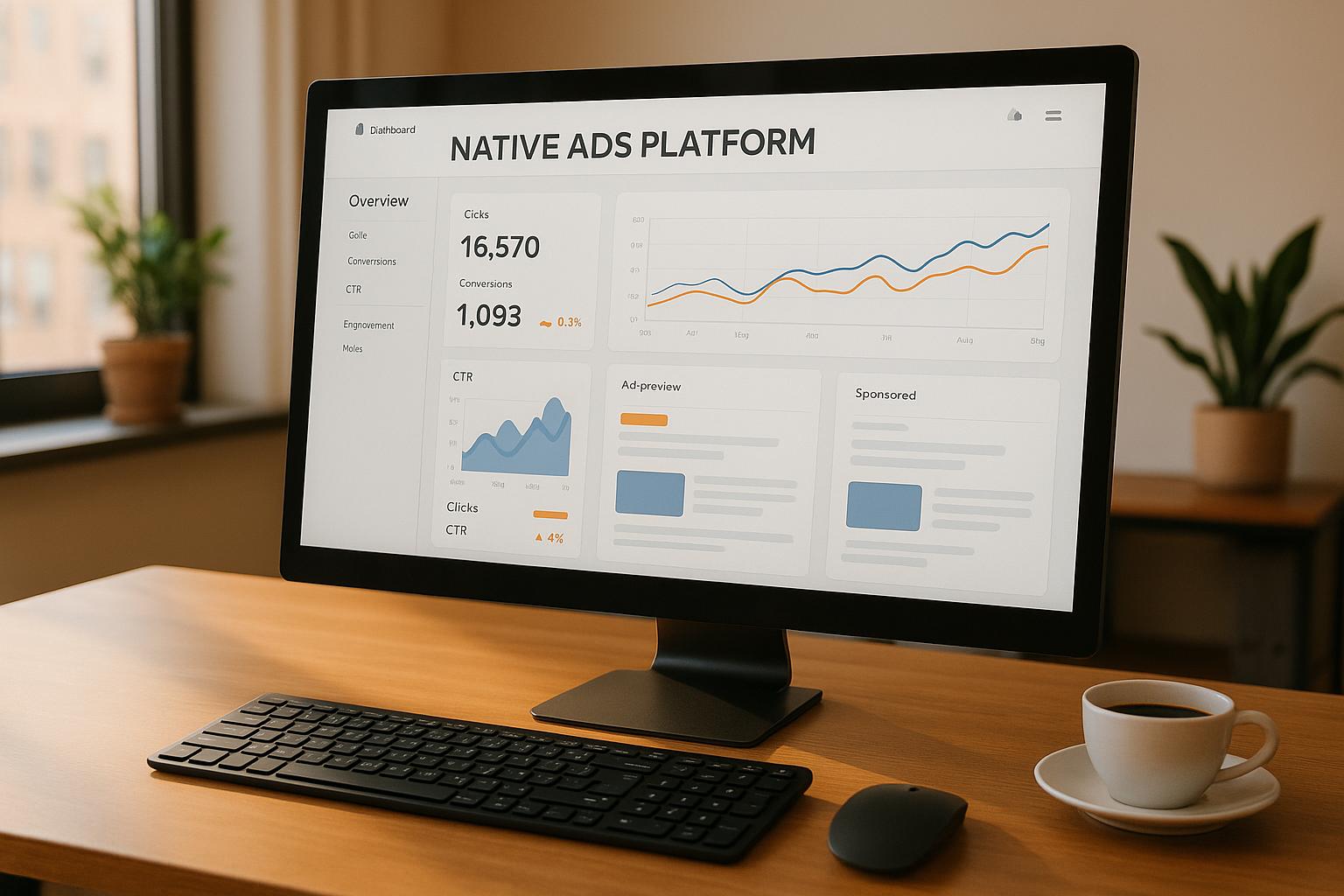Want to make money from your website? Display ad networks can help. They connect advertisers with website owners, making it easier to earn revenue from your traffic. Here’s what you need to know:
- Ad Placement Matters: Ads above the fold and within content perform best.
- Choose the Right Network: Look for diverse advertisers, advanced targeting, and transparent reporting.
- Use Targeting: Contextual and behavioral targeting improves ad relevance and revenue.
- Track Performance: Monitor metrics like CPM, CTR, and viewability to optimize earnings.
- Diversify Revenue: Combine ads with affiliate marketing, newsletters, or e-commerce for stable income.
Platforms like TinyAdz simplify this process with tailored ad placements, detailed analytics, and multiple monetization options. Start by testing placements and tracking results to maximize your website’s potential.
How to Layout Your Website & Ads for Maximum Monetization
How to Pick the Right Display Ad Network
Selecting the right display ad network is a key step in building a successful monetization strategy. The right match can turn your website's traffic into consistent revenue without compromising the user experience.
What Ad Network Features Matter Most
When evaluating ad networks, one of the most important factors to consider is the diversity of their advertiser base. Networks with a broad pool of advertisers often provide higher-quality ads, which can lead to better earnings through improved eCPMs.
Another critical factor is traffic quality. Prioritize networks that ensure 100% human traffic by using robust bot filtering systems. This protects your revenue and helps establish trust with reputable advertisers.
Targeting capabilities are also essential. Look for networks that offer demographic, behavioral, and interest-based targeting. These features allow you to serve ads that resonate with your audience, boosting click-through rates and overall engagement.
Additionally, choose networks that provide a variety of ad formats - such as banners, native ads, video, directories, and newsletters - and offer real-time, transparent reporting. This ensures that ads integrate smoothly with your website’s design while giving you clear insights into performance metrics like impressions, clicks, and audience demographics.
TinyAdz is a great example of a network that incorporates these features into its offerings.
What TinyAdz Offers Website Owners

TinyAdz addresses the key features website owners look for in an ad network, delivering increased revenue opportunities through targeted campaigns and diverse monetization options. Plus, it guarantees 100% human traffic for reliable results.
With a personalized matchmaking system, TinyAdz connects your site with advertisers that align with your audience. This tailored approach ensures campaigns are more relevant, leading to higher engagement and better revenue potential.
TinyAdz also offers flexibility in how you monetize. Whether you prefer banner ads, directory listings, social media placements, newsletters, or event promotions, TinyAdz provides a centralized platform to manage all your revenue streams.
Transparency is another standout feature. TinyAdz offers detailed reporting, so you always know where your revenue is coming from. There are no hidden fees or confusing metrics - just clear, actionable insights.
How to Check if an Ad Network Fits Your Website
Once you’ve identified potential networks, the next step is to assess how well they align with your website’s audience and technical requirements. Start by defining your audience profile to ensure the network’s advertiser base matches your content and user interests.
Consider testing the network with a 30- to 60-day trial period before committing long-term. Many reputable networks offer trial runs without requiring minimum traffic levels or exclusive contracts. During this time, monitor key metrics like fill rates, eCPM, and user engagement to evaluate performance.
It’s also important to confirm that the network complies with U.S. privacy laws, such as the CCPA. Ensure they provide tools for consent management and respect user privacy preferences.
Finally, review the support and resources offered. Look for responsive customer service, detailed knowledge bases, and technical assistance to help you fine-tune your ad strategy. Don’t forget to check payout terms and minimum thresholds to make sure their payment system aligns with your financial goals.
Where and How to Place Ads for Best Results
Placing ads strategically on your website can make a big difference in revenue. The key is to ensure that your ads are positioned in areas where visitors are most likely to see and engage with them.
Best Spots to Put Your Ads
Above-the-fold placements are highly effective. These are the ads that appear as soon as someone lands on your page, without any scrolling required. They boast a 73% viewability rate compared to just 45% for ads placed below the fold.
The header area is another prime spot, especially for banner ads like the 728x90 format. Placing these just below your navigation menu can grab attention right away.
In-content ad placements are a smart choice for engaging readers. For example, inserting a 300x250 ad after the first or second paragraph often performs well.
Sidebar placements work particularly well for longer articles. Sticky sidebar ads, such as 300x600 or 160x600, tend to maintain high visibility throughout the reader’s session.
Isolated column placement can also be effective. This strategy separates ads from the main content, minimizing accidental clicks while keeping ads noticeable to users who are genuinely interested.
Which Ad Types Work Best
Once you’ve picked the best spots, choosing the right ad format is just as important.
Banner ads are a staple of online advertising and remain highly effective. With an average click-through rate of 0.6%, these ads are particularly good for building brand awareness. Popular sizes include 728x90 for headers, 300x250 for in-content areas, and 320x50 for mobile screens.
Sidebar ads often outperform traditional banners, achieving click-through rates around 1%.
Video advertising is another powerful format, especially for sites that host multimedia content. Video ads tend to capture more attention and drive higher engagement compared to static alternatives.
The trick is to align ad types with how users interact with your site. Tools like Google Analytics and heatmaps can help you identify high-engagement areas.
Setting Up Ad Sizes and Tracking Reports
After deciding on placements and formats, getting ad sizes right and tracking performance are essential steps.
Stick to standard ad dimensions, as they tend to deliver better fill rates.
Since mobile traffic now dominates, optimizing for mobile is a must. Use responsive ad units and lazy loading to ensure smooth performance on smaller screens.
Keep ad density in check. Ads should take up less than 30% of your page content to avoid overwhelming your audience.
Track key metrics like viewability, click-through rates, and RPM (Revenue Per Mille). Setting up conversion tracking can help you pinpoint which placements generate the most revenue.
Finally, A/B testing is a great way to fine-tune your approach. Experiment with different placements and formats, then use the data to make informed adjustments.
Using Targeting to Show Better Ads
Targeting allows ads to connect more effectively with specific audience interests and behaviors. When ads align with what your visitors care about, it’s a win-win: your audience gets relevant content, and you see better revenue results.
Once your ad placements are strategically set up, targeting takes their performance to the next level.
How to Target Ads to Specific Audiences
To target ads effectively, leverage demographic, behavioral, and geographic data. Studies show that targeted ads are twice as effective as non-targeted ones, contextual ads get 50% more clicks, and retargeting can increase conversions by an impressive 147%. Additionally, about 80% of millennials say they prefer ads tailored to their location.
Here’s a breakdown of common targeting strategies:
- Contextual targeting: Matches ads to the content on your site. For instance, a fitness blog might display ads for workout gear or protein supplements, keeping the ads relevant to the audience.
- Behavioral targeting: Uses tools like cookies and analytics to track visitor interactions and create detailed profiles. This helps serve ads based on a user’s past activity.
- Geographic targeting: Focuses on location data to deliver ads tailored to specific areas, making them locally relevant.
- Retargeting: Re-engages visitors who left your site without completing a desired action, encouraging them to return and convert.
TinyAdz's Tools for Personalized Ads
TinyAdz offers a powerful system that matches publishers with advertisers perfectly suited to their audience. By guaranteeing 100% human impressions, TinyAdz significantly reduces the impact of bot traffic. Plus, their transparent reporting tools provide valuable insights into how different audience segments respond to specific ad types, helping you fine-tune your placements for maximum impact.
Whether you’re monetizing a blog, newsletter, directory, or social media account, TinyAdz’s precision-targeted approach ensures your visitors see ads that align with your content seamlessly.
Following U.S. Privacy Laws
In the U.S., several state laws govern how visitor data can be collected and used for advertising. For example, the California Consumer Privacy Act (CCPA) gives residents the right to know what data is being collected, request its deletion, and opt out of the sale of their information. States like Colorado, Connecticut, Utah, and Virginia have implemented similar requirements, with some even mandating data protection assessments for targeted advertising.
To stay compliant, take the following steps:
- Create a privacy policy that clearly explains how you collect, use, and share personal data.
- Include a visible "Do Not Sell Or Share My Personal Information" link on your site.
- Use consent management systems to track and store user consent.
- Ensure your targeting systems respect universal opt-out signals so that a visitor’s preferences apply across all campaigns.
sbb-itb-957fd63
How to Track Ad Performance and Boost Earnings
Turn guesswork into actionable strategies by using data to refine your approach and maximize your earnings.
Key Metrics to Monitor
Will Johnson, Account Manager at Pathlabs, highlights the importance of tracking key performance indicators (KPIs):
"Using KPIs in display ad campaigns is important because display is a method widely adopted by marketers, with many investing hundreds to thousands of dollars into these types of campaigns. Without tracking these KPIs, marketers would be running these expensive campaigns blindly without knowing how they are actually performing or if they are effectively reaching their objectives."
Here are some of the most important metrics to keep an eye on:
- Click-Through Rate (CTR): This shows the percentage of ad impressions that result in clicks. With the average Google Ads CTR at 3.17%, hitting or surpassing this benchmark means you’re on the right path.
- Cost Per Mille (CPM): This measures how much you earn for every 1,000 ad impressions. For instance, a CPM of $2.50 means you earn $2.50 for every 1,000 ad views.
- Conversion Rate: This metric reveals how many ad clicks lead to conversions, directly linking to your revenue.
- Return on Ad Spend (ROAS): This compares the revenue generated to your ad spend. For example, spending $100 on ads and earning $400 in revenue gives you a ROAS of 4:1.
- Viewability: Tracks the percentage of ads that users actually see.
- Reach and Frequency: Reach measures the number of unique users exposed to your ads, while frequency shows how often an individual user sees them.
These metrics provide the foundation for building effective strategies and tools to improve your ad campaigns.
Tools to Track Ad Performance
Platforms like TinyAdz offer straightforward analytics to help you understand how your ads and earnings are performing.
"See how your ads or earnings are doing with easy-to-understand stats."
Beyond TinyAdz, tools like Google Analytics can provide deeper insights into user behavior. For example, you can track which pages generate the most clicks, how long users stay after interacting with ads, and which traffic sources drive the best results.
Heatmap tools are another valuable resource. They visually highlight where users focus their attention on your site, making it easier to identify the best ad placement zones. Real-time analytics can also be a game-changer, allowing you to spot trends and make optimizations within hours.
Strategies to Boost Ad Revenue
Using performance data effectively can lead to smarter decisions about ad placements and targeting, ultimately driving higher earnings.
- A/B Testing: Experiment with different ad positions and sizes to see what works best for your audience. For example, test the same ad in multiple locations over two weeks and compare the results.
- Audience Segmentation: Tailor ads to specific visitor groups based on their interests. Research shows that 29.2% of people prefer ads that align with their interests, and 81% feel more positive when they see relevant ads.
- Optimize Website Performance: A fast-loading site improves user experience and ad viewability. Even a 2-second delay can hurt satisfaction. Techniques like lazy loading can boost site speed and improve ad performance.
- Multi-Sized Ad Placements: Offering various ad sizes increases the chances of filling inventory and attracting clicks.
Will Johnson offers this practical advice:
"Lastly, marketers must keep the number of KPIs they track limited to those that best represent performance. While numerous display KPIs exist, tracking too many can lead to confusion and distract from what truly matters. Selecting and monitoring a few key metrics will ensure marketers stay focused on the critical factors indicative of campaign performance. In summary, go back to the objective, find a KPI that directly measures it, and choose to track only the best ones."
Stay focused on the metrics that align with your revenue goals. For example, if boosting earnings is your priority, concentrate on CPM, CTR, and ROAS rather than vanity metrics.
Finally, make it a habit to review your performance data regularly. Weekly analysis can help you identify trends early, adjust underperforming placements, and build on what’s working. Over time, this consistent attention to your metrics can lead to a noticeable increase in revenue.
More Ways to Make Money Beyond Website Ads
Expanding beyond traditional display ads can open up new revenue opportunities for publishers. While ads are a reliable starting point, diversifying income streams can help stabilize earnings and reduce dependency on a single source. Platforms like TinyAdz are now enabling publishers to monetize through newsletters, social media, events, and more.
Other Ways to Monetize Your Content
Digital monetization isn’t just about ads anymore - it’s about creating multiple streams of income that work together. Some of the most effective methods today include affiliate marketing, newsletters, events, e-commerce, and social media monetization. TinyAdz has streamlined these options into one integrated platform.
Affiliate marketing, for example, is a major player in online revenue. During Cyber Monday 2024, affiliate marketers contributed over 20% of U.S. e-commerce revenue. This shows how powerful partnerships and product recommendations can be.
Newsletters are another growing avenue. As John Rush puts it:
"The people who own traffic/attention can finally easily monetize it. The founders who wanna buy traffic/attention can finally do that with one click."
Events are also becoming a lucrative option. According to the Innovation Consulting Group, some publishers now generate up to 20% of their total income from events. This approach is gaining traction as companies seek creative ways to diversify their revenue.
E-commerce and merchandising are booming, too. With U.S. e-commerce projected to hit nearly $1.2 trillion by 2025, the potential is enormous. A great example is The Daily Wire, which earned over $22 million from commerce in 2023, including $19 million from its Jeremy's Razors line.
Social media monetization is evolving quickly. Platforms are increasingly enabling direct purchases, eliminating the need for external links. Together, these channels provide a solid complement to traditional display ads, broadening your revenue base.
Benefits of Using Multiple Revenue Channels
Having multiple income streams offers several advantages. For starters, it reduces reliance on a single channel, making your earnings more stable even during economic shifts or platform algorithm changes.
For example, a publisher using TinyAdz's aitoolsfor directory earned $1,263 from just 18,000 views and 4,000 clicks. This demonstrates how specialized channels can generate meaningful revenue alongside traditional ads.
Diversified channels can also boost audience engagement. The New York Times found that subscribers who interact with both games and news content in a given week show stronger long-term retention. Offering varied content helps maintain audience interest while increasing loyalty.
Another key benefit is reduced risk. If one channel underperforms, others can help balance the impact. Additionally, these channels often reinforce each other, amplifying overall revenue potential.
Comparing Monetization Methods
Choosing the right monetization mix depends on your audience and content type. Here’s a breakdown of some popular methods:
| Monetization Method | Best For | Revenue Potential | Setup Difficulty |
|---|---|---|---|
| Display Ads | High-traffic blogs, news sites, evergreen content hubs | Moderate to High | Easy |
| Affiliate Marketing | Review-based or how-to content in tech, fashion, wellness, finance | High | Moderate |
| Subscriptions | Creators in education, lifestyle, commentary | High | Moderate |
| Digital Products & Courses | Experts and educators who solve specific problems | Very High | High |
| Brand Sponsorships | Influencers with defined and engaged audiences | High | Moderate |
| E-commerce/Merchandising | Brands with loyal followings | Very High | High |
To succeed, it’s vital to align your content with your audience’s interests. For instance, when working with sponsored content, choose brands that resonate with your readers and always disclose partnerships to maintain trust.
Tracking performance is equally important. Metrics like revenue per user, conversion rates, and customer retention can help fine-tune your strategy. For subscription models, focus on delivering real value behind paywalls. For e-commerce, consider tactics like limited-edition releases to create urgency.
The most successful publishers don’t rely on just one method. Instead, they build comprehensive strategies that combine multiple revenue streams while staying true to their audience. TinyAdz’s multi-channel platform makes it easier than ever to tap into these opportunities, offering tools to monetize websites, social media, newsletters, and events all in one place.
Key Points for Website Owners
Monetizing your website with display ads is all about striking the right balance - boosting revenue while maintaining a smooth user experience. In the U.S., digital ad spending accounts for over 30% of the market, making it a lucrative opportunity for website owners.
Choosing the right ad network is critical. TinyAdz offers a flexible solution with no minimum traffic requirements. Its focus on niche targeting ensures your ads reach real, engaged audiences, maximizing their impact.
Ad placement matters more than you might think. Research shows that buyers exposed to a vendor's banner are 84% more likely to interact with that vendor and 32% more likely to consider them for future purchases. Smart placement not only drives immediate clicks but also builds long-term brand visibility. Experimenting with different formats - like banners and native ads - can help you figure out what clicks (literally) with your audience.
Targeting is the game-changer. Precision in audience targeting is what separates average publishers from top performers. For example, most businesses aim for at least a 200% return on their ad spend. TinyAdz’s personalized matchmaking system connects your content with advertisers looking for your exact demographic, boosting click-through rates and keeping advertisers happy.
Diversify your revenue streams. Relying on just one channel can be risky. TinyAdz makes it easy to monetize not just your website but also your social media, newsletters, and even events - all from one platform.
Track your performance. Keeping an eye on key metrics is essential for improving results. TinyAdz provides straightforward reporting tools to help you monitor and optimize your campaigns. With global programmatic ad spending expected to hit $595 billion in 2024 and nearly $800 billion by 2028, staying ahead of trends is crucial. And while chasing growth, don’t forget: a fast-loading website with quality content benefits both your visitors and advertisers.
Stay compliant. For U.S.-based website owners, privacy laws like the CCPA are non-negotiable. Partnering with ad networks that handle compliance automatically can save you time and maintain your audience’s trust.
Ultimately, the most successful publishers approach display advertising as part of a bigger content strategy. By combining high-quality content, strategic ad placement, sharp audience insights, and diversified monetization efforts, you lay the groundwork for sustainable growth in today’s competitive digital space. TinyAdz’s focus on quality placements and user experience makes it a strong ally in achieving these goals.
FAQs
What are the best ways to choose ad placements on my website to increase revenue?
To boost revenue, prioritize horizontal ads at the top or bottom of your site for mobile users. These spots tend to grab more attention and drive higher engagement. For desktop users, vertical ads placed on the left or right sides of the page often stand out more, thanks to their visibility.
You should also explore targeted ad placements by focusing on specific pages or sections of your website that align with your audience's interests. This approach not only enhances the user experience but also increases the chances of clicks and conversions, ultimately improving your earnings.
Don't forget to keep an eye on your ad performance. Use analytics tools to track what’s working, and tweak your strategy as needed to get the best results.
What should I look for when selecting a display ad network for my website?
When selecting a display ad network, it's crucial to focus on aspects that align with your website's goals and your audience's preferences. Start by looking at the network's targeting options - features like geographic or behavioral targeting can help ensure the ads truly connect with your visitors. Next, consider the ad formats available, such as banners, video ads, or native ads, and choose formats that complement your site's layout and enhance user experience.
You'll also want to ensure the network provides strong performance tracking tools. These tools are essential for keeping tabs on revenue and engagement, helping you make informed decisions. Don’t overlook the network's pricing models - whether it's CPM or CPC, pick the one that fits your strategy and revenue goals. Finally, make sure the network adheres to U.S. advertising laws, as this is key to maintaining trust and transparency with your audience. The right network will strike a balance between generating income and delivering a positive experience for your users.
How can I comply with U.S. privacy laws when using display ad networks on my website?
To stay aligned with U.S. privacy laws when using display ad networks, begin by drafting a privacy policy that clearly outlines how you collect, use, and share user data. It's essential to secure explicit consent from users before collecting or sharing any personal information.
Keep up-to-date with regulations such as the California Consumer Privacy Act (CCPA) and other emerging state-specific laws. Regularly assess and update your practices to ensure they meet current legal standards. Being transparent and proactive not only helps with compliance but also strengthens trust with your audience.


